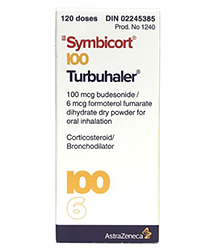What is Symbicort Turbuhaler used for?
Using Symbicort Turbuhaler, you can control and prevent symptoms of asthma and ongoing lung disease such as chronic bronchitis and emphysema (chronic obstructive pulmonary disease-COPD). Formoterol is a corticosteroid that works by reducing inflammation and irritation of the airways. Budesonide is an inhaled corticosteroid that works by reducing irritation of the lungs. Formoterol belongs to the class of drugs known as long-acting beta agonists. It opens up the airways by relaxing the muscles around them. The symptoms of troubled breathing can be controlled in order to reduce working or school time lost. The importance of learning how to get the most out of the medication cannot be overstated. If an asthma attack occurs, use your short acting inhaler as directed (such as albuterol, which is called salbutamol in some countries).
Symbicort Turbuhaler FAQs
How To Use Symbicort Turbuhaler?
Inhalers that haven't been used for more than seven days or inhalers that have been dropped must be primed as instructed. Inhalers should be sprayed away from the face when they are priming to prevent medication from entering the eyes.
It's usually recommended that you use this medication twice daily (in the morning and evening, 12 hours apart) by inhaling it by mouth. You should shake the inhaler well for five seconds before each use.
It is recommended that you wait at least one minute between the two puffs if your prescription calls for 2 puffs. If you are using other medications at the same time, wait at least 1 minute between each medication and use this last.
It is important not to swallow the rinse water after each use to prevent dry mouth, hoarseness, and oral yeast infections.
The inhaler should be cleaned once a week with a dry cloth. The inhaler should not be taken apart for cleaning. In addition to your medical condition, the dosage depends on how well you respond to treatment.
The best way to benefit from this medication is to use it regularly. This medication works best when used evenly spaced apart. Don't increase your dose, stop using this medication without first consulting a doctor. Use it at the same time each day to help you remember. If you are taking this medication along with another long-acting beta agonist, you must avoid taking them together.
When a corticosteroid (e.g. prednisone) is regularly taken by mouth, you should not suddenly stop the medication without consulting your doctor. As well as withdrawal symptoms, you may also experience weakness, weight loss, nausea, muscle pain, headaches, fatigue, and dizziness if you suddenly stop taking the drug. Following your doctor's recommendation, your dose of your old medication may be gradually reduced to protect you from withdrawal symptoms.
You should tell your doctor or pharmacist if you experience withdrawal symptoms. See Precautions for more information. Inhalers that provide quick relief (such as albuterol, also known as salbutamol in some countries) should be used regularly (such as four times per day), This schedule must be stopped and you must only use the quick-relief inhaler when you become short of breath or have an asthma related event.
You may have an increased risk of cataracts or glaucoma. You may need to have your eyes examined during treatment. Seek immediate medical attention if you experience an irregular heartbeat.
Your pharmacist or doctor should be able to answer any questions you may have.
What are the possible side effects of Symbicort Turbuhaler?
The most commonly reported side effects of Symbicort Turbuhaler include:
- Stuffy Nose
- Throat Irritation
- Muscle Cramps
- Increased Thirst or Urination
- Signs of Infection (Such as Fever, Persistent Sore Throat)
- Stomach Upset
- Changes in Your Voice
- Headache
- Diarrhea
- Shaking (Tremors)
- Trouble Sleeping
- White Patches on Tongue or in Mouth
- Back Pain
- Vomiting
- Nausea
- Mental/mood Changes (Such as Nervousness)
- Muscle or Joint Pain
- Vision Problems (Such as Blurred Vision)
- High blood pressure
There are other side effects that may occur that are not listed on this page.
Additional information about side effects can be obtained from your physician.
What are Drug Interactions of Symbicort Turbuhaler?
Few known Drug Interactions of Symbicort Turbuhaler are listed below:
- Stuffy Nose
- Changes in Your Voice
- Vision Problems (Such as Blurred Vision)
- Diarrhea
- Muscle Cramps
- Stomach Upset
- Mental/mood Changes (Such as Nervousness)
- Back Pain
- White Patches on Tongue or in Mouth
- Shaking (Tremors)
- Increased Thirst or Urination
- Throat Irritation
- Nausea
- Muscle or Joint Pain
- Headache
- Vomiting
- Signs of Infection (Such as Fever, Persistent Sore Throat)
- Trouble Sleeping
A complete list of Symbicort Turbuhaler Drug Interactions is not available on this page.
Consult your physician if you have any questions about this medicine's drug interactions.
How much does Symbicort Turbuhaler cost in Canada?
Starting price of Symbicort Turbuhaler 100 mcg/6mcg cost in Canada
- 120 doses - $97.65 USD ($0.81 per doses)
- 240 doses - $193.20 USD ($0.81 per doses)
- 360 doses - $275.63 USD ($0.77 per doses)
Starting price of Symbicort Turbuhaler 200 mcg/6mcg cost in Canada
- 120 doses - $124.95 USD ($1.04 per doses)
- 240 doses - $241.50 USD ($1.01 per doses)
- 360 doses - $338.09 USD ($0.94 per doses)
